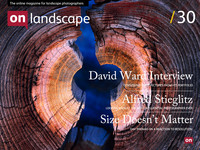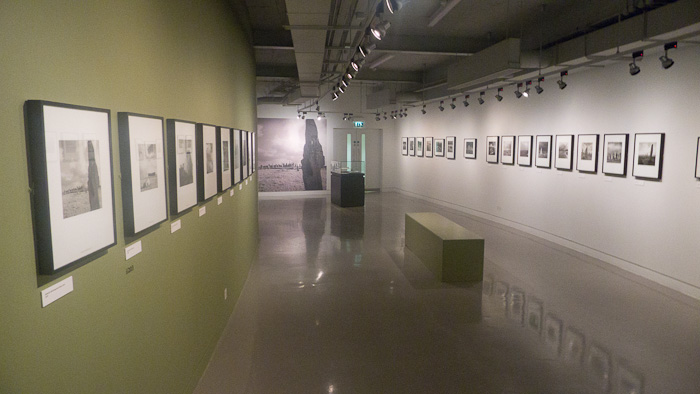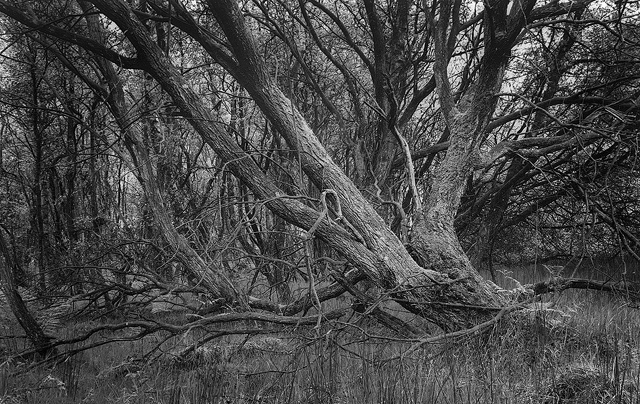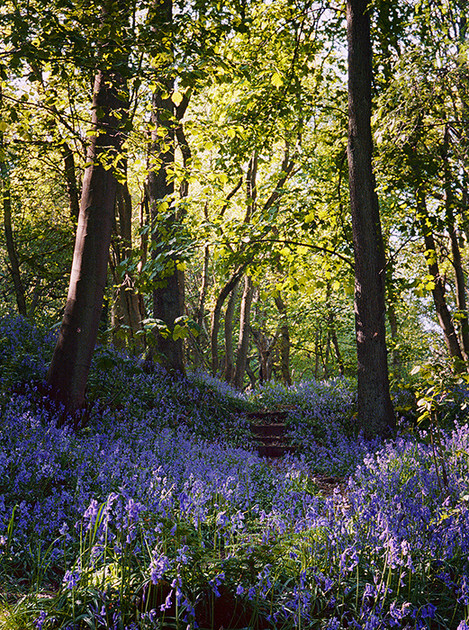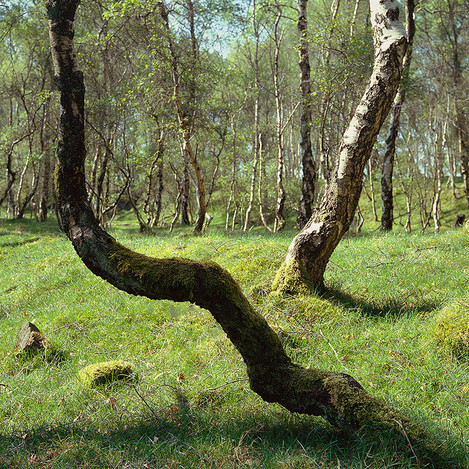Is Bigger Really Better?
I had the pleasure of coming along to Tim’s Big Camera Comparison which featured in Issue 28. As we know, being the ultimate geek, Tim loves to compare pretty much everything photographic – cameras, resolution, film, colour, you name it. And congratulations to Tim for putting together such a thorough and informative test.
I got the chance last week to look at print outs from the test of the landscape view, some differences were noticeable on the larger prints which featured a tiny section of the overall image and from the blind test of which ones I preferred, I think I picked the 4x5 Portra 400 shot and a 4x5 Velvia as my top two – generally the wasn’t an overwhelming difference between them, apart from the P45 back, which looked terrible. On the smaller prints, you really couldn’t choose much between them, other than some better colour in the film images, sharpness, detail and all that was much the same.
Even during the day of testing I was thinking to myself ‘so what?’, resolution, megapixies – it doesn’t matter, it’s an endless and wildly expensive path to follow.
So, I thought I’d put my thoughts down about this whole resolution thing and why, ultimately, it doesn’t matter.
Big, Big Big!
In this rather troubling age, it all seems to be about big – more pixels, bigger prints, more followers, more Flickr comments, but why? Of course in the relatively calm days before digital things were pretty stable, 35mm was the norm for most folks and medium and large format were the the standard formats in the studio. We were happy with what we got out of our chosen mediums and cameras advanced at a sedate pace with ‘improvements’ fast auto focus and better metering. Print sizes were really dictated by darkroom technology, so A1 prints were unusual. Then along came Epson and their bubbles, and as ink jet printers improved, making big prints from home became a normal pastime. Obviously the bigger we choose to print, the bigger the source image needs to be, whether it’s film of digital.
Now I believe this whole ‘print big’ thing is a norm that needs questioning, and can, in some cases, be foolish. The fact is, most people don’t need to print large and in some ways I believe it’s detrimental to the photography and limited selling possibilities.
I went to the Fay Godwin exhibition in Bradford last year, other than a couple of large prints (that didn't really look so good), the prints were small, maybe 12" square or so and mounted with the usual wide gallery mounts and black frames. The beauty of images at that size is that the viewer engages with them – you can’t really look at them too closely from a distance because of their size - so you’re forced to get up to them, you view them from a couple of feet away. At this sort of viewing distance you focus fully on the image, your angle of vision extends little further than the edge of the frame. Now imagine if these images were A1 sized - I have to stand considerably further away to view the image as a whole and as a consequence I have more chance of being distracted by the next image which is only the flick of the eyes away. There’s also a more personal connection with a small print – it’s size dictates that only I am likely to look at it at any one time, we share a moment with the photo and with the photographer, whereas with a large print, you often end up side by side with one or more people, rushed into your enjoyment and pushed into moving on.
At these smaller framed sizes the camera equipment is taken out the equation, sure it will have effected the photographic process, but not the viewing process. Most camera can produce a fine print at sizes up to 10"x8", at that size it’d be pretty hard to tell between a 12 megapixel camera and a large format scan (from a realistic viewing distance at least), this was evident in the print outs from The Big Camera Comparison. A 35mm film camera is certainly capable of producing a fine 10"x8" print and at a push, could probably manage nearly twice that size – as could a lesser pixeled dSLR.
Something else I've found whilst selling my work at shows and exhibitions is that people just haven't got room for mega sized prints in their houses. There may be room above the fireplace for a large framed print but if these are people who are willing to spend a few hundred pounds on a photograph, they’re the sort of people who will have already filled that space up before your photo came along!
I've heard many times people saying ‘I really like that but I'd have nowhere to put it – have you got a smaller version?’. People are also not so keen on spending lots of money without serious consideration. Small prints which allow for a more modest budget are much more likely to sell. Small prints are also much easier frame and are much easier to store.
And then, of course, there are those photographers who buy the latest pixeled up gear and never actually print anything, they look at their images on screen, magnify in and look at all those lovely pixels. Well, I guess if that’s what you want to do...
The tradition of small
Traditional photographers haven't felt the need to print big, if you were to see a Michael Kenna original print, for example, you’d find that they are actually smaller than you’re used to seeing them in the multitude of calendars that are around – a tiny 8"x8" print mounted to 20"x16". You pay for the art with Kenna, not the print acreage! I also recall that Lord Ansel Adams' prints I saw at the exhibition of his work in Edinburgh were generally around the 10"x8" size and smaller.
If you really must
OK, so maybe you want some big prints to go along with your lovely small ones. At an exhibition, I did this year I chose to show four large framed prints with sixteen smaller images It’s a technique that worked well for me and one I'd certainly do again. Obviously, I couldn’t have produced the large prints without something like a large format camera or an IQ180 – well, actually, I could.
Stitching offers a world of possibilities for large prints. With a (fair) bit of work, I'm sure I could produce a file that would match a large format camera or IQ180 with my old Nikon D200
Even without stitching I could get prints that looked perfectly acceptable out of my 10.2 megapixled D200 up to A2 size – they wouldn’t be as bitingly sharp as those produced with the Sony A900 I have today, but I'd rather you didn't wipe your snotty nose on my picture glass – I'd rather you stood a at a more respectable distance away!
Ultimately it’s about the image, it’s not about the technology.
The Joy of Different Cameras
Whilst I never see myself selling everything I own in order to buy an IQ180, or the newer version that’ll come out next year (probably), I have many cameras - from a small army of 35mm SLRs to a couple of large format 4x5s and a full frame digital. Whilst many photographers are happy to stick to just digital, or just large format or whatever, for me, the process of using different cameras makes for different approaches and helps to keep my photography fresh.
This is the crux of it for me – it’s not about if one camera is sharper than the next, or if one produces a file that’s 100mb bigger than that one – it’s about the cameras and how they make you work.
I’m currently working on a self imposed project photographing in an area of woodland. I decided to use 35mm film cameras for this project because, for one reason or another, it suited the way I wanted to work. As a result of the prints I produce form the project will be limited to a certain size, but so what! For this particular project, the majority of final images will probably be printed no bigger than 10"x8" – these aren’t Wow! pictures, I want the viewer to view them up close, as I did when I viewed the Fay Godwin exhibition.
As my project has developed I have started using other cameras along side the 35mm – my Pentacon Six medium format has come along with me, as has my 4x5s, and even my dSLR once or twice! For me, using different formats makes me interact with the subject in different ways and that’s why I’m unlikely to stick to one type of camera. It frees me up, makes me work differently and hopefully keeps my work fresh.
The same is true of using Holgas or even iPhones – it’s not about resolution, it’s about art! If you’re limited by the size of the final file embrace it, use it as an advantage not a hindrance.
People won’t pay more for resolution
This really only applies if you want to sell your photos, or even just give them away to friends and family.
A framed print is a framed print – the general public really don’t care less if a photo is taken with a £10 SLR or a 40k digital back – all they care about is the image – do they like it, does it move them, and sadly; does it match their colour scheme and will it fit in their house?
I occasionally do arts fairs, where, amongst my framed prints, I have a large format camera on display, mainly to draw attention to our large format workshops – I inevitably get asked repeatedly ‘were these taken with that?’ (pointing generally at my work) Generally, people are surprised, (the next question normally follows ‘can you still get film for that?’) You then have to explain about quality, size of transparency etc. Not all of my prints are taken with a large format camera, it must be pretty clear from this article that I use many types of cameras. I normally tell our questioning show visitor that most of them were taken with a large format camera. After that, they look at the prints, and normally... don’t buy anything! If I’m lucky and they do get their wallets out I’ve hardly ever had anyone ask me what the particular photo they have chosen was taken with – they don’t care, they just like the picture.
Last year I bought a Fujica ST605N 35mm camera on Ebay with a 55mm lens for the princely sum of £3.99. It’s an unassuming little camera which works fine. I took it out, along with my Pentacon Six 6x6 medium format camera to my local bluebell woods where I got a photo – nothing amazing, but reasonable enough. I’ve since sold 3 framed prints of the image (which was scanned on a Nikon IS-2000 Film scanner which cost me £33) – if only all camera purchases could pay for themselves so quickly!
If I were to have two 10x8 sized prints, mounted and framed the same way but one taken with a top of the range digital back on a diabolically expensive Alpa camera body, and one made with my Chamonix 4x5 large format and one of the second hand lenses I use (maybe £900 worth of equipment), Tim’s tests prove that there would be very little difference between the two prints. The fact is I would not be able to charge any more for the print made on the super expensive camera – I'd have to get to be a mighty popular photographer to sell enough prints to cover the cost of the digital back and Alpa!
Be creative with your prints
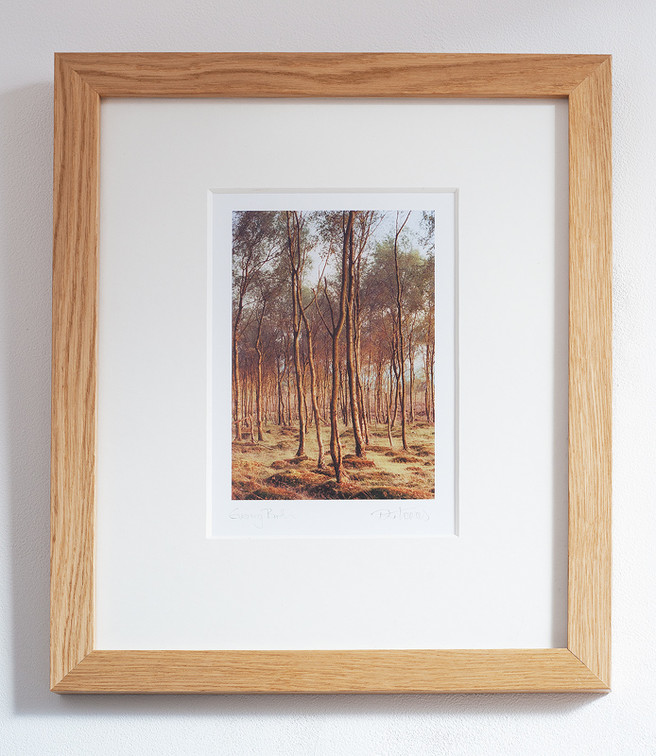
You may well have the latest Canon DSLR and a super lovely inkjet printer, but without care and consideration, it’ll make no difference if they’re mounted and framed badly. I actually think that a well framed print can add value (both visually and economically) to the final piece. I have an established method of framing my work – I like to make a border out of the actual print and mount with a big margin. I always use thick mountboard as it gives a better perceived quality, and I use plain wood or black or white mouldings.
I have two examples here of two framed prints I made today to go along with this article. The first image I made with a very lovely Pentax Spotmatic 35mm camera, I could have printed this at least twice the size I have but I think it works great at this size (the actual image is about 12cm x 28cm and the frame is 32cm x 39cm) by framing it with wide borders, thick mount and signing the actual photo it gives it a greater perceived quality – no one will ever care that it’s made with an old 35mm camera, hopefully they’ll just enjoy the image and it’s presentation.
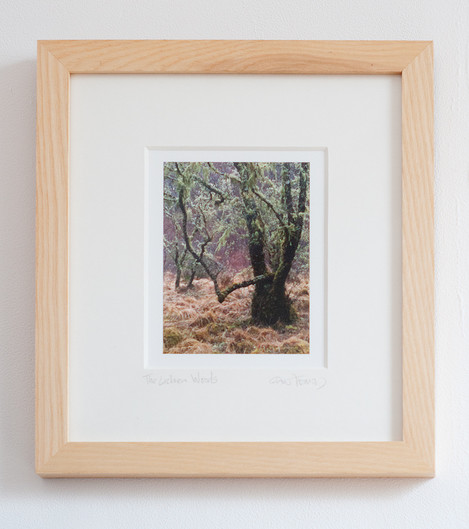
To push things to extremes I thought I'd have a go at printing something from my iPhone (and it’s not even a new iPhone with a good camera), I managed a print that’s about 24cm x 20cm and mounted and framed it nicely. I showed it to my girlfriend who’s used to seeing my prints and asked her what she thought – could she see anything out of the ordinary about it? She couldn’t (she even said it was nice)!
I’m not suggesting we all go and sell our expensive camera equipment but it goes to show that you can produce perfectly good work with cameras that most people wouldn’t give the time of day too.
Forget about megapixies - it’s about colour
What Tim’s Big Camera Test highlighted was the fact that whilst 4x5, 10x8 and IQ180s can all produce images that are sharp that you could print the size of Norwich, in my opinion film has the edge on digital in terms of colour fidelity. You’d only really know this if you compared the two side by side (and I wouldn’t suggesting taking an IQ180 out alongside your 10x8). The P45+ looked positively hopeless. The film cameras still had a life to them that wasn’t present in the digital images, and some colour that the digital cameras couldn’t replicate. This colour rendering isn’t particular to large format film cameras, it’s there still on the lowliest of film formats.
It shouldn’t be about resolution anymore – we’ve got enough. It will be interesting to see how the new Fuji X-Pro works out with its X-Trans CMOS sensor, will it make for better colour rendition?
Stating what’s been stated many times before
Maybe the most ignored statement in photography goes something like ‘expensive equipment doesn’t make you a better photographer’. The general reaction might be ‘yes quite right.... oooh look, a new Canon 5Dmk3 with more...things!’ I think it may be the case that easier to use equipment makes you a better photographer. I've experienced this with large format cameras – a client on a workshop had a Wista 45DX – an obvious beginner’s large format choice due to their modest price – it has to be one of the worst pieces of camera equipment I've ever used! Focusing it is a thoroughly miserable experience and folding it up after you’ve battled with it is like mastering one of those annoying wooden puzzles I always seem to get at Christmas. Compare that with the experience of using my regular Chamonix camera which costs only a couple of hundred pounds more and you'd see that, even though they both aim to do the same thing, using the Chamonix is a much more desirable and enjoyable experience. If I were made to use the Wista for a week and then the Chamonix for a week I suspect the Chamonix would make me a better photographer just because it’s more pleasurable and easy to use – I’d actually want to make photos with it.
I’m sure the same is true of digital cameras – usability is something that’s overlooked, trumped by megapixel power. Fiddly controls, nested menus, dim viewfinders (or viewfinders that look like a scene from Tron). I chose my digital camera not because it had thousands of modes, flashing lights, video, but because it didn’t – I don’t want a camera’s fancy antics to get in the way of me and the subject.
It’s all very fancy but...
I've harped on about this before, but I'll repeat myself if I may... Photography at its best is an art form. Sure, if you’re having to photograph toilet seats (that was a perhaps a low point in my career) art probably doesn’t come into it too much; but generally with landscape, fashion, architecture, street photography... it’s about art. Putting your own creative slant on your photography is what it’s about, it’s how you get to stand out from the crowd. And art isn’t about megapixies, it’s about the final image.
Other forms of art, painting and sculpture for example contain within their brush strokes or chisel marks, slight flaws, that when combined as a whole make the work unique and brilliant – unintentional yet brilliant gestures that give the work character. This is what makes the process of making the art so compelling and engaging. Compare this with current trends in landscape photography – the IQ180, clever as it is, takes the art out of photography. Press a button and it’ll show you what’s in focus – it’s computerised photography – where’s the art in that!? Of course this is a fantastic way of working if you’re a commercial photographer, it’s not going to wash if I produce out of focus product photography for a client, ‘oh yeah – it’s art’ isn't going to appease the client! But how many of us are working as commercial landscape photographers where computerised perfection is required? Not many.
We need to question what we’ve photographing the landscape for, where’s the connection, what does it mean to us? It’s not a technical exercise, or at least it shouldn’t be, it’s about making images that mean something to us and hopefully, those who view our photographs.
You can see more of Dav’s work at www.peaklandscapes.com

